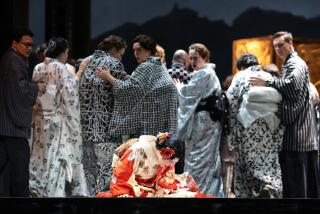BALLET REVIEW : A Fine British ‘Beauty’ Awakens in Houston
HOUSTON — Ballet may be ailing in Southern California, but it seems to be enjoying the best of health--artistic as well as financial--deep in the heart of Texas.
The Houston Ballet, which bills itself as the fourth largest dance company in America, attained professional status only in 1969. Under Ben Stevenson, the British choreographer who assumed leadership 14 years ago, Houston has developed a versatile ensemble that even can dance, when the occasion warrants, in a reasonably Royal manner.
Now elegantly ensconced at the Wortham Center, the 49-member company operates with an annual budget of $9 million. Houston Ballet claims to enjoy the largest endowment of any comparable institution in the country. Texans, we are reminded, think big.
Stevenson and friends are thinking big these days with a splendid new production of “The Sleeping Beauty,” staged in commemoration of the 100th anniversary of the St. Petersburg premiere. The local price tag: a mere $757,000.
The director’s friends in this instance turned out to be advocates of an enlightened British, as opposed to Russian, tradition. Desmond Heeley, the designer, created pastel images that often invoked the historic Sadler’s Wells decors of Oliver Messel. To complement the obvious nostalgic impulses, Stevenson imported a special coach from London via Panama: Margot Fonteyn.
In her time, this Beauty probably was the most beautiful of them all. Her presence here ensured refinement of detail and reinforced an authentic aristocratic aura amid the high American spirits.
The production, wildly cheered by a full house on Thursday, represents a triumph of dedication and style. The scale may be a bit small in the corps scenes--Stevenson reduced the Garland Waltz, for instance, to a rather perfunctory peasant divertissement-- and virtuosity cannot be taken for granted on all levels. Heeley’s generally handsome sets teeter from time to time on the brink of candy-box kitsch. Nevertheless, this “Beauty” is marvelously poignant at best, merely picturesque at worst.
Unlike his Soviet colleagues, Stevenson is careful about telling the story. He makes pointed use of mime. He revels in the fairy-tale antics of the wedding celebration, and, abetted by Heeley, lets no one forget that the intermission between Acts I and II spans a full century.
His choreographic scheme respects the customary modified-Petipa formulas in all the important places. This, however, does not preclude some imaginative innovations.
Most notable among them is the promotion of Carabosse from a caricature drag crone to a dangerous ballerina who actually dances en pointe . The interestingly evil fairy in this version becomes a not-so-distant cousin of the Black Swan. As such, she also becomes a sensible, formidable counterforce for the goody-goody Lilac Fairy. It is a nice touch.
If Houston has a prima ballerina, she must be Janie Parker. One of four alternating Auroras, she burst into the party scene on Thursday with innocent radiance and then made time stand still with the balances of the Rose Adagio. The only serious problem here: an odd pink tutu with puffy-gauzy sleeves that compromised the perception of her line.
Parker went on to define the mysteries of the Vision Scene with genuine lyric suavity, and she plunged into the fishdives of the grand pas de deux with reckless abandon. This was a promising performance by a major artist.
She was partnered with gentle security and princely ardor by Li Cunxin, a noble Houston danseur from Tsing Tao in the People’s Republic of China. If only he happened to be a few inches taller . . .
Kristine Richmond exerted magnetism in the flamboyantly nasty maneuvers concocted for Carabosse (Stevenson likened the figure to Joan Collins in toe shoes). Rachel Jonell Beard, by comparison, seemed correct yet needlessly pallid as the Lilac Fairy. John Grensback and Martha Butler creditably stressed charm rather than bravura in the Bluebird pas de deux.
The caractere specialists included three niftily athletic Ivans (Mark Arvin, Timothy O’Keefe and Li Anlin) and a genuinely seductive White Cat blessed with terrific legs (Susan Bryant). The assorted, hard-working fairies, nymphs, cavaliers and courtiers attested to good schooling, a few passing gaffes notwithstanding.
Terence Kern, the British guest-conductor, attended to Tchaikovsky efficiently and accommodated the dancers sympathetically. The pit seemed a bit understaffed.
Meanwhile, in Los Angeles . . .
More to Read
The biggest entertainment stories
Get our big stories about Hollywood, film, television, music, arts, culture and more right in your inbox as soon as they publish.
You may occasionally receive promotional content from the Los Angeles Times.










